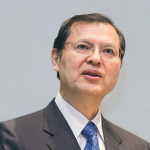 The “Justice” chapter of volume 27 of The New Human Revolution was serialized in the Seikyo Shimbun from January to March of 2014, shortly after the completion of the Hall of the Great Vow for Kosen-rufu in November 2013. The Soka Gakkai theme for 2014 was designated as The Year of Opening a New Era of Worldwide Kosen-rufu, and this chapter clarifies that at the start of this new phase it is crucial that we keep in mind the following:
The “Justice” chapter of volume 27 of The New Human Revolution was serialized in the Seikyo Shimbun from January to March of 2014, shortly after the completion of the Hall of the Great Vow for Kosen-rufu in November 2013. The Soka Gakkai theme for 2014 was designated as The Year of Opening a New Era of Worldwide Kosen-rufu, and this chapter clarifies that at the start of this new phase it is crucial that we keep in mind the following:
Only by keeping alive in members’ hearts the noble spirit of selfless devotion to propagating the Law demonstrated by Mr. Makiguchi and Mr. Toda could the fundamental spirit of the Soka Gakkai be passed on and the pure stream of kosen-rufu spread and grow into a mighty river.[1]
In this chapter, we learn how this noble spirit has been embraced by the Soka Gakkai’s three founding presidents—Tsunesaburo Makiguchi, Josei Toda and Daisaku Ikeda. I believe that for the Soka Gakkai to make yet another great leap forward as a global religious movement, what matters most is that we inherit this spirit and put it into practice in our daily lives.
When first president Tsunesaburo Makiguchi took faith in Nichiren Buddhism in 1928, he sought to “return to the original teachings of Nichiren Daishonin and walk the great path of a genuine disciple, in exact accord with the Daishonin’s spirit,”[2] rather than merely carry out the practice of Nichiren Shoshu, which had lapsed into formality and become ritualistic like the other long-standing Buddhist schools in Japan.
In the midst of World War II, the Nichiren Shoshu priesthood, fearing persecution by the militarist authorities [who were seeking to unite the country around State Shinto to support the war effort], agreed to accept a Shinto talisman. Both Mr. Makiguchi and Mr. Toda adamantly refused to accept the talisman, which subsequently led to their detention and to Mr. Makiguchi’s death in prison, ending his noble life of selfless dedication to propagating the Law.
Determined to carry on his mentor’s commitment to kosen-rufu, second Soka Gakkai President Josei Toda set about rebuilding the lay organization after his release from prison [on July 3, 1945]. While continuing to support and protect Nichiren Shoshu, he was aware of the fact that an undesirable tendency to look down upon the laity persisted in the priesthood and resolutely took a stand against such priests.
In the same spirit as his mentor, Shin’ichi Yamamoto had also done his utmost to protect and support Nichiren Shoshu, at times saying what needed to be said in order to maintain harmonious relations between the laity and the priesthood. Many among the Nichiren Shoshu priesthood, however, resented his advice on the proper and acceptable behavior of priests, and a prevailing attitude of superiority to the laity persisted among them.
The priesthood’s antagonism toward the Soka Gakkai is then exacerbated by the secret maneuvering of Tomomasa Yamawaki, a lawyer involved with both the Soka Gakkai and the priesthood, whose intention was to control the Soka Gakkai behind the scenes. From around 1976, he had begun spreading inflammatory rumors among some priests, who, manipulated by these rumors, start repeatedly maligning and attacking the Soka Gakkai.
In response to these attacks, Shin’ichi determines that what is important is that each member “establish deep and unwavering faith, and firmly embody the Soka mentor-disciple spirit dedicated to the mission of realizing kosen-rufu.”[3] Resolved not to leave a single person behind, he pours his energies into offering encouragement, traveling to eight regions outside Tokyo between January and May 1978, in order to meet with the members. In June, he visits Hokkaido, the ninth region of his guidance tour that year. During his 16-day stay there, he travels across the island taking commemorative photographs with about 5,000 members and meeting over 20,000 members in total.
Learning from the spirit described in the “Justice” chapter is not only relevant for those of us practicing today as we mark the 30th anniversary of the Soka Gakkai achieving its spiritual independence from Nichiren Shoshu [in November 1991]; it represents the starting point and fundamental spirit of the Soka Gakkai to which future generations should always return.
Our Tohoku Soka family
In May 1978, during a journey to visit the recently completed Soka Gakkai Tohoku Peace Center (later renamed the Aoba Peace Center) in Tohoku’s Miyagi Prefecture, Shin’ichi shares with those accompanying him his feelings of respect and admiration for the members of this northeastern region. He states, “The strength of our Tohoku members derives from bravely rising to the challenge of each adversity they have encountered—such as the 1960 tsunami caused by an earthquake in Chile, or crop damage from cold weather—and creating ever-greater momentum for kosen-rufu.”[4]
Since the Soka Gakkai’s early days, Shin’ichi had watched how the members in Tohoku had striven courageously for kosen-rufu. In the “Seeking Spirit” chapter, he affirms that they have shown the greatest actual proof of faith in the form of “treasures of the heart,” demonstrating the true power of Nichiren Buddhism. Surely, this can also be said of their steady, day-to-day efforts to rebuild their communities since the March 2011 Tohoku earthquake and tsunami.
On March 7 this year, our Soka family in Tohoku held a “Bonds of Hope” general meeting commemorating 70 years since the start of kosen-rufu in the region as well as 10 years of recovery to restore the light of happiness to their hometowns. The meeting, held at the Tohoku Culture Center and broadcast live to 147 venues across all six prefectures in the Tohoku region, was attended by about 10,000 members. The enduring, golden bonds they have established both with their mentor and among themselves shine as a source of hope for the world.
In his essay “Our Brilliant Human Revolution: The Light of Happiness of Human Triumph,” carried in the March 11, 2021, Seikyo Shimbun and marking exactly 10 years since the Tohoku earthquake and tsunami, Ikeda Sensei expresses his great hopes and expectations for the members there. He writes, “The underlying power of the people of Tohoku, so strong in the face of adversity, is the driving force for value creation that will open a new era.” He further adds that in our movement’s efforts to make this a century of life and a century of human revolution, it is none other than our “beloved Tohoku Soka family” that will “play a key role in solidifying the foundations for our movement.” With this encouragement in their hearts, our fellow members in Tohoku have made a powerful new start.
In the “Seeking Spirit” chapter, there is also a scene where Shin’ichi calls on the leaders of the six Tohoku prefectures, encouraging them to look ahead toward the next 10 years and to scale the peaks of kosen-rufu together with him. “Fresh steps give way to fresh hope,”[5] he remarks.
I am certain that the incredible efforts made by our fellow members in Tohoku to restore the light of happiness in the region will continue to shine ever more brilliantly in the coming decade as we advance toward the Soka Gakkai’s centennial in 2030.
A New Age for Soka Education
The Tokyo Soka Elementary School opened in April 1978. In the “Young Shoots” chapter, Shin’ichi states that, with the school’s opening, “we are now entering the second phase of development in Soka education.”[6] Amid his busy schedule, he makes time to visit the school as its founder to encourage the students and staff. His feelings toward Soka students and graduates are captured here:
Shin’ichi also regarded himself as one with the Tokyo Soka Elementary School and all the other schools that made up the Soka school system. The growth of the Soka students currently enrolled and the activities of the graduates in society brought him incredible joy.[7]
At the first graduation ceremony of the Tokyo Soka Elementary School, held in March 1982, he encourages the students, “Always thinking of what you can do for peace, please give your all to developing your abilities.”[8]
On March 16 this year, the school held its 40th graduation ceremony. In his message to the graduates, Sensei passionately declares that as founder, he considers his life and the lives of the students as “one and inseparable, for all eternity.” His constant attention to all those who have studied at Soka institutions has remained unchanged.
This year, we celebrate Soka University’s 50th anniversary on April 2 and Soka University of America (SUA)’s 20th anniversary in Aliso Viejo, California, on May 3. It was also recently announced that the Soka International School Malaysia (SISM) is due to open in 2023. The day when the graduates of SISM pursue further education at either Soka University or SUA is now on the horizon. This is indeed the start of “an age when Soka education will show its true worth.”[9]
Translated from the March 24, 2021, Seikyo Shimbun, the Soka Gakkai’s daily newspaper.
Summary of Contents
Young Shoots
On April 9, 1978, the Tokyo Soka Elementary School holds its first entrance ceremony. The Kansai Soka Elementary School is opened in April 1982.
Justice
Although the Soka Gakkai is committed to the correct practice of Nichiren Buddhism, some priests of Nichiren Shoshu launch attacks on it. At chorus festivals across the nation, the members give voice to the truth and justice of Soka.
Fierce Struggle
In May 1978, Shin’ichi Yamamoto travels extensively to encourage the members in Tokyo, Kagoshima, Fukuoka, Yamaguchi and Hiroshima.
Seeking Spirit
Shin’ichi visits Tohoku and Hokkaido to foster capable people.
The official English translation of volume 27 will be published in the future. As such, the translations of excerpts from this volume are subject to later revision.
You are reading {{ meterCount }} of {{ meterMax }} free premium articles

